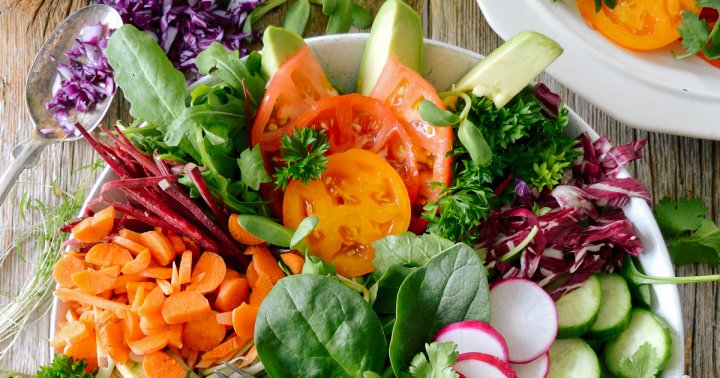Eating These 7 Foods Can Help Prevent Uterine Fibroids (And What to Avoid)
Many women have or will experience uterine fibroids in their lifetime. Luckily, there are natural preventative measures that you can take to prevent or slow fibroid growth. One way? Adopting a uterine fibroid diet that eliminates certain foods while...


Many women have or will experience uterine fibroids in their lifetime. Luckily, there are natural preventative measures that you can take to prevent or slow fibroid growth. One way? Adopting a uterine fibroid diet that eliminates certain foods while eating more of other types of foods.
Fibroids are benign tumors that develop in the uterine wall, while endometriosis involves the growth of endometrial-like tissue (similar to uterine tissue) outside the uterus (where it shouldn’t be). It is important to note that endometriosis and fibroids are two separate medical conditions.
Uterine fibroids are benign tumors that grow within the smooth muscle tissue of the uterus. As many as three in four women will experience fibroids in their lifetime.
For some people, fibroids will not produce symptoms or cause problems. However, others may experience fibroids that are physically painful, debilitating, and can even lead to serious reproductive or other health challenges.
As many as three in four women will experience fibroids in their lifetime.
The good news is that lifestyle factors, particularly nutrition, can help prevent fibroids and/or slow their growth. Foods which are rich in nutrients like Vitamin D, antioxidants, and minerals are linked to reduced risk for fibroids. If you or someone you know have fibroids, consider adopting a diet for fibroids for prevent and slow fibroid growth.
This article will delve into what fibroids are and how they are diagnosed, their potential symptoms and complications, and the foods and nutrients which reduce risk for and/or limit the growth of uterine fibroids.
What Are Fibroids?
According to the American College of Obstetricians and Gynecologists, uterine leiomyomas (commonly known as fibroids) are benign, non-cancerous growths that develop from the muscle tissue of the uterus. They are the most common type of growth found in a woman’s pelvis.
Fibroids can form in different sizes, shapes, and locations in the uterus (such as inside the uterus, on the outer surface, or within the wall). Some are small, around the size of a pea, while others can be large, round growths that are at least 5 or 6 inches wide.
As they grow, uterine fibroids may distort the inside and/or outside of the uterus, and in severe cases can grow large enough to fill the pelvis or abdomen.
How Are Fibroids Diagnosed?
Fibroids are commonly detected and diagnosed during pelvic exams. Technologies such as ultrasound, hysteroscopy, and/or laparoscopy may be used to confirm the presence of uterine fibroids.
What Causes Fibroids?
The exact cause of uterine fibroids has not been determined, though some research indicates that they develop from misplaced cells which are in the body before birth. Estrogen and progesterone appear to play notable roles in fibroid growth.
The U.S. Department of Health & Human Services’ Office on Women’s Health reports that between 20 and 80 percent of women develop fibroids by age 50.
Certain factors may increase your risk for fibroids, including age, family history, and diet.
Age: Fibroids become more common in women in their 30s and 40s through menopause. However, fibroids usually shrink after menopause.
Family History: Women are more likely to develop fibroids if fellow relatives, such as their mother or sister, have had them. Additionally, research shows that Black women are at higher risk for fibroids compared to white women.
Diet: Diets high in red meat, particularly beef and ham, are linked with a higher risk of fibroids, while consumption of fruits and vegetables appears to protect against fibroid development.
What Are Common Symptoms of Fibroids?
Fibroid symptoms vary greatly from person to person and range from asymptomatic to severe. While most uterine fibroids aren’t necessarily harmful, some fibroids can lead to complications.
Symptoms of fibroids include:
Longer, more frequent, or heavy menstrual periods Menstrual pain/cramps Vaginal bleeding at times other than menstruation Dull, heavy, aching, and/or sharp pain in the abdomen or lower back Pain during sex Difficulty urinating or frequent urination Constipation, rectal pain, or difficult bowel movements Abdominal cramps Enlarged uterus and abdomenPotential complications from fibroids include:
Pain, nausea, and/or fever Abdominal swelling Anemia (from blood loss) Miscarriages InfertilityTreatment for symptomatic fibroids will be individualized and is determined by factors like the size of the fibroid(s) and severity of symptoms.
Some fibroids may be managed by medication, but others may require surgery to be removed, such as myomectomy (which preserves the uterus) or hysterectomy (which removes the uterus).
What Is the Recommended Diet for Fibroids?
Unfortunately, diet alone may not be sufficient to prevent or cure fibroids. However, nutrition can supplement a regimen developed by a medical professional for treatment and management of fibroids.
Research has found a consistent link between Vitamin D deficiency and the development of uterine fibroids. Vitamin D is found in fatty fish like salmon and tuna, eggs, fortified milk and non-dairy milk, and wild mushrooms.
Additionally, many phytochemicals found in fruits and vegetables have demonstrated the ability to shrink fibroids and halt their growth.
Read: Phytochemicals: A Guide to Eating the Rainbow With a Plant-Based Diet
Eat a Preventative Uterine Fibroids Diet – These Are the Top 7 Foods for Fibroids:
Here is a list of the top seven foods that research has shown have benefits towards managing fibroids. Some of these fibroid-fighting foods have been listed below together because they contain the same compounds.
1. Green Tea
Green tea contains a compound called epigallocatechin gallate (EGCG) which is anti-inflammatory and has been shown to inhibit the growth of tumors including fibroids.
A study in the International Journal of Women’s Health revealed that reproductive-age women with fibroids who received 800mg of green tea extract daily for four months had significant reductions in the total volume of their uterine fibroids and in the severity of their fibroid symptoms.

2. Berries and Apples
There are many bioactive compounds in fruits which can prevent and slow the growth of uterine fibroids. These include anthocyanins, found in berries, and apples that offer protective properties against the growth of fibroids.
A 2017 laboratory study found that strawberry extract resulted in the destruction of uterine fibroid cells, while a cohort study by Wise et al indicated that women with higher fruit intake were less likely to have fibroids.
3. Broccoli, Cabbage, and Tomatoes
Vegetables also have powerful phytochemicals that have demonstrated potential to prevent or shrink uterine fibroids.
A Chinese study found that foods like broccoli, and cabbage, offered protection against uterine fibroids and women with fibroids were less likely to report consuming these foods. Lycopene, a carotenoid found in tomatoes, also plays a significant preventative role.
Thus, a preventative uterine fibroids diet is one that is rich in these fruits and vegatables.
4. Turmeric
Turmeric contains curcumin, which has several health benefits like reducing inflammation and oxidative stress in the body. According to a study from the American Society for Reproductive Medicine, curcumin may also be effective at slowing the growth of uterine fibroids.
Read: 9 Incredible Health Benefits of Turmeric
Avoid These Foods to Help Reduce the Likelihood of Uterine Fibroids:
There are also foods that may increase the likelihood of fibroid development. Consider the following foods what not to eat in your preventative diet for fibroids.
1. Alcohol
The California Teacher’s Study found that drinking 20 grams or more alcohol per day was correlated with an increased likelihood of needing surgery for fibroids.
2. Red Meat
Fibroids appear to be more common in populations with higher intakes of red meat, particularly beef and ham.
3. Refined Carbohydrates
Foods that are high on the glycemic index (such as white bread, pasta, and soft drinks) may increase risk for uterine fibroids for some women with hormone-responsive tumors.
4. Soy
While the relationship between soy and the development of tumors (including fibroids) remains controversial, some studies did find that frequent soybean consumption was associated with a higher risk for fibroids.
5. Pollutant Chemicals Found In Certain Foods and Household Items
It is also worth noting that some pollutant chemicals such as those found in fertilizers, pesticides, BPA, nonstick coatings on cookware, fire retardants, dyes, and paints can disrupt hormone balance and increase risk for uterine fibroids.
Read: Glyphosate In Your Food: What You Need to Know About This Chemical and Your Health
A Uterine Fibroids Diet Is Key for Prevention
Many women will encounter uterine fibroids in their lifetime, and the experiences often vary from person to person. It is highly recommended to get pelvic exams routinely, particularly if you have a family history of fibroids.
Fibroids will generally only need treatment if they are causing symptoms. Treatments for uterine fibroids include medications and surgeries, and will be personalized to the individual’s medical situation and reproductive goals.
Research has shown that adopting a uterine fibroids diet, particularly foods which are rich in Vitamin D and antioxidants, can play a role in preventing and/or reducing growth of fibroids. Incorporating many fresh fruits and vegetables, green tea, turmeric, and dairy can reduce fibroid risk, while alcohol, red meat, refined carbohydrates, and/or soy may increase risk.
If you suspect that you may have uterine fibroids, it is important to contact your medical provider or OBGYN as soon as possible to confirm diagnosis and to follow all professional advice.
All included information is not intended to treat or diagnose. All views expressed within this article are the author’s. Always consult your healthcare provider for medical questions and before beginning or changing any dietary, supplementation, and exercise regimen.

 ValVades
ValVades 






























